5 Questions With . . . MB&B’s Scott Holmes on Gene Expression, Genetics

This issue, we ask “5 Questions” of Scott Holmes, associate professor of molecular biology and biochemistry. He received a three-year grant from the National Science Foundation (NSF) to support his research on epigenetic silencing of gene expression.
Gene expression refers to the observable characteristics generated on a molecular level by a particular sequence of DNA or gene; epigenetic controls are essential in maintaining the specific patterns of gene expression that distinguish hundreds of distinct cell types in skin, muscles and other types of tissue. Epigenetic mechanisms also explain how humans can have more than 200 distinct cell types.
Q: Professor Holmes, you are an expert on genetics, molecular biology and chromosome structure. What led you to an interest in genetics and what does your lab research?
A: I had a strong affinity to genetics both as a field of study and as an experimental approach. Our DNA is present in our cells in structures known as chromosomes. My lab is addressing fundamental questions about how these structures are organized, and how that organization influences the function of genes present on the DNA. To accomplish this we primarily use genetic tools. In a directed manner we manipulate genes that we know or suspect will influence the structure of chromosomes, then assess the consequences of these changes.

Q: Last year, you received a three-year grant worth $599,832 from the National Science Foundation to support your research titled “Epigenetic Silencing of Gene Expression in Saccharomyces cerevisiae.” Please explain what epigenetic controls are and what role do they play in gene expression.
A: Most people are familiar with the basics of genetics: the DNA sequence of any two individuals varies by about 0.1 percent (about 1 in 1,000 positions in the DNA sequence), and some of that variation is manifested in measurable ways in our biochemistry, physiology, and outward appearance. Epigenetics refers to situations in which two cells or organisms have identical DNA sequences, yet establish distinct patterns of gene expression and exhibit different characteristics. Epigenetic mechanisms explain how humans can have over 200 distinct cell types despite the fact that all our cells have exactly the same DNA. The distinct gene expression patterns in these different cell types are dictated by their unique chromosome structures; we’d like to know how these structures are initially established, and then how they are inherited as cells grow and divide.
Q: What is the advantage of using Saccharomyces cerevisiae, a budding yeast, for studying gene expression?
A: Budding yeast has been used for centuries for baking and brewing; it’s also a great model organism for addressing basic questions of chromosome structure and gene expression. Much of what we know about the fundamental nature of chromosome structure and gene expression in humans was first discovered in yeast cells. Besides being very easy to grow and maintain, we have powerful tools to conduct genetic experiments with yeast, including the ability to alter their DNA sequence. Many of these techniques are quite straightforward, making it a great system for engaging undergraduates. A local advantage is the presence of two other faculty in my department, Amy MacQueen and Mike McAlear, who also use yeast to address their research questions. We share resources and have joint lab meetings in a semi-regular schedule.

Q: This summer you worked with three undergraduates as part of the 10-week-long Wesleyan Hughes Summer Outreach Program. What do students gain from the program?
A: I worked with three undergraduates this summer: Kuan-lin Huang ’12, Dessie Stefanova ’12 and Priyanka Moondra ’13, who joined three graduate students who are pursuing Ph.D. research in my lab. All the undergraduates had their own projects, and were expected to push the research forward. Undergraduates can get a taste of research by working in labs during the academic year, but the full time immersion that the Hughes program makes possible is a key for them to discover if they have a genuine affinity for research science as a career, and to acquire sufficient skills to make significant progress on their research.
Q: What courses do you teach at Wesleyan, and which is your favorite to teach?
A: For the last two years my principal teaching assignments have been introductory biology in the fall (MB&B 181: Cell Biology and Molecular Basis of Heredity), and an advanced lab course in the spring (MB&B 294: Advanced Laboratory in Molecular Biology and Genetics). The lab course can be logistically challenging, but is my favorite course to teach. We develop projects that allow the students to address real research questions while introducing them to a variety of techniques and approaches in molecular genetics. Lecture is deemphasized, so I get to interact more with the students than in my other courses. We’ve generated novel and interesting results almost every year I’ve taught the course, which keeps both me and the students engaged. I’ve had a number of excellent students move from the lab course into independent research projects in the lab.

